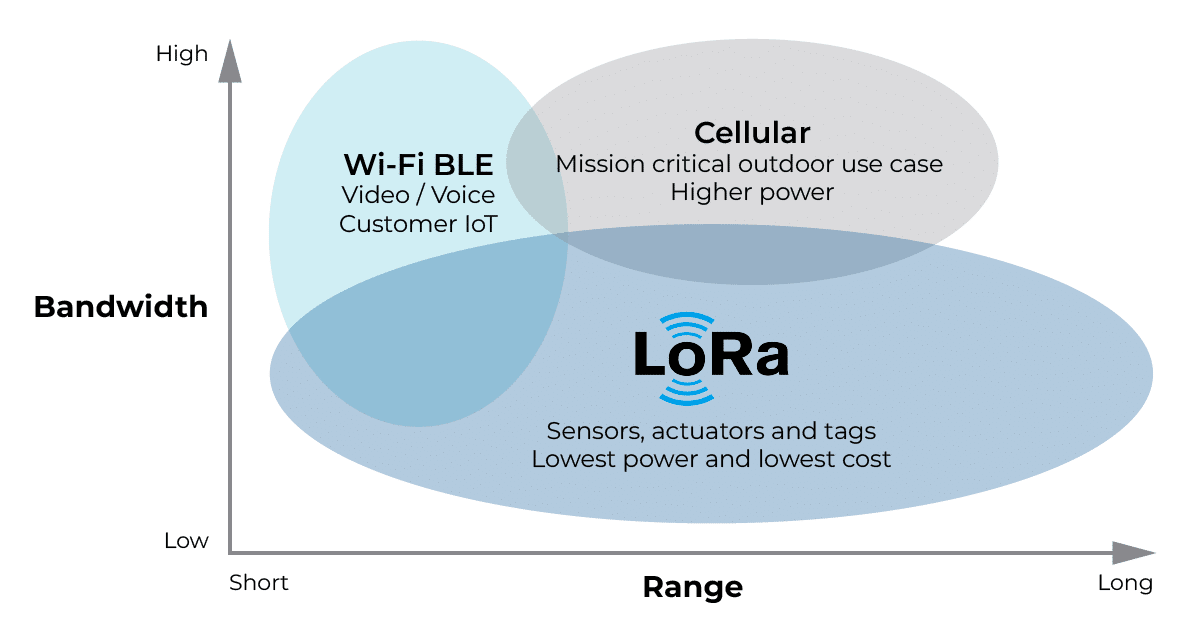Due to the widespread adoption of wireless technologies for IoT (Internet of Things) applications, the coexistence of Low-Power Wide Area Networks (LPWANs), such as LoRa and Wi-Fi, has become a topic of interest. They both are used in various IoT applications, such as smart buildings, smart cities, industrial automation, and agriculture, to enable communication between devices and sensors.
LoRa is frequently used in Building IoT applications
LoRa is a low-power, long-range wireless communication protocol that uses a wide-bandwidth modulation scheme to provide coverage over a large area. It operates in the unlicensed sub-gigahertz frequency band, which means it can be used without requiring a license from regulatory bodies. LoRaWAN is recognized by the International Telecommunication Union (ITU) as an LPWAN standard.
LoRa is designed to provide low-power, low-data rate communications between sensors, gateways, and the cloud. The main advantage of LoRa is its long-range coverage (see figure below), which allows it to be used in applications where Wi-Fi is not feasible due to range limitations. Additionally, LoRa is a highly secure and scalable technology with its long range and low power consumption making it ideal for use in large-scale IoT deployments by IoT professionals.

With its low-power, long-range coverage, Lora fills a technology gap in the Building IoT
Wi-Fi: high-speed data transfer in offices, houses and public spaces
Wi-Fi, on the other hand, operates in the 2.4 GHz and 5 GHz frequency bands and is designed to provide high-speed data transfer over a limited area. Wi-Fi is commonly used in homes, offices, and public spaces to provide wireless internet access. The main advantage of Wi-Fi is its high-speed data transfer capabilities, which allow it to support a variety of multimedia applications, such as streaming video and audio, gaming, and file transfers.
Are LoRa and Wi-Fi interference concerns justified?
One of the concerns for IoT professionals and device manufacturers is whether LoRa and Wi-Fi will interfere with each other. However, this is an issue of little relevance because both have different operating frequency bands and design objectives. As a result, they do not interfere with each other. The frequency band used by LoRa (433MHz to 915MHz) is typically much lower than the frequency bands used by Wi-Fi (2.4 GHz and 5 GHz). This means that there is little overlap between the two technologies, which reduces the likelihood of interference. Additionally, the different design objectives of LoRa and Wi-Fi (long-range coverage vs. high-speed data transfer) ensure that they are not competing for the same resources, which further reduces the likelihood of interference.
Can LoRa and Wi-Fi coexist?
In terms of coexistence, LoRa and Wi-Fi can coexist as they use different modulation techniques. LoRa uses a spread-spectrum modulation technique that spreads the signal over a wide frequency band, allowing for increased range and lower power consumption. Wi-Fi, on the other hand, uses a narrowband modulation technique that focuses the signal in a narrow frequency band, which increases data rate and reduces interference.
Additionally, LoRa technology uses adaptive data rate (ADR) to dynamically adjust the data rate based on the signal quality, ensuring that the signal remains strong and reliable. This means that even if there is Wi-Fi interference in the area, the LoRa signal will automatically adjust to ensure that it continues to operate effectively.
In conclusion
Overall, the coexistence of LoRa and Wi-Fi is largely a non-issue in the Building IoT domain because they have different operating frequency bands and design objectives, which reduce the likelihood of interference. IoT professionals and device manufacturers can use both technologies in their applications without worrying about any significant interference.











